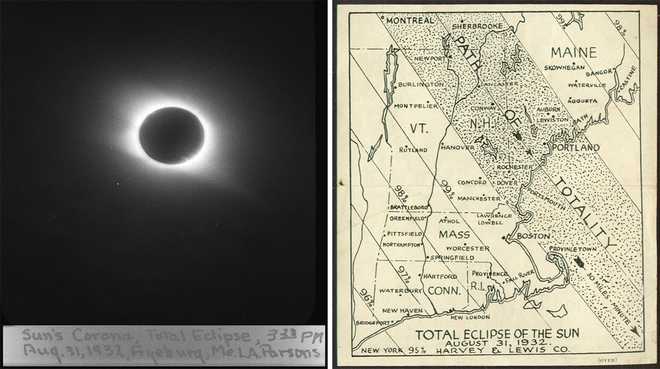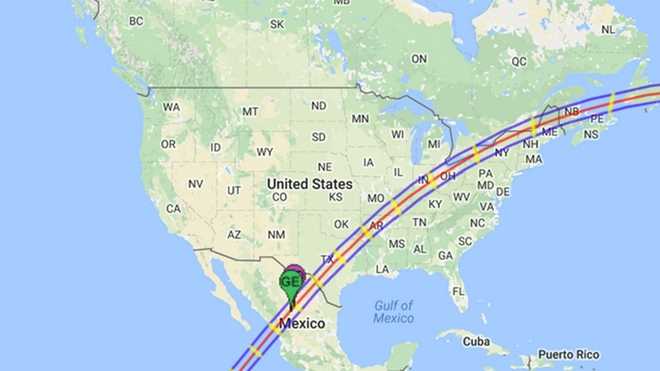OF THE MONEY APRIL 8, 2024 IS OFFICIALLY SOLAR ECLIPSE DAY IN NEW HAMPSHIRE. THAT’S WHEN WE’LL BEING SEEING A TOTAL SOLAR ECLIPSE. THE STATE EXPECTS A LOOFT TOURISTS, ESPECIALLY IN THE NORTH COUNTRY WHERE IT WILL BE PEAK VIEWING. THIS MORNING, THE GOVEORRN SIGNED A BILL MAKING THE DAY’S SPECIAL DESIGNATION OFFICI.AL AFTER 2024, THE NEXT TOTAL ECLIPSE WILL NOT HAPPEN UNTIL 2079. KEVIN: YOU KNOW WHAT MAKES ME NERVOUS ABOUT THAT?
Advertisement
New Hampshire 100 days away from total solar eclipse
Eclipse on April 8, 2024, will be New Hampshire’s first total solar eclipse since 1959
Some Granite Staters and people around the world are counting down the days until the total solar eclipse crosses the U.S. in 2024.Granite Staters have been fortunate enough to see this breathtaking phenomenon in the past.New Hampshire saw its only total solar eclipses over the last 150 years, in 1932 and 1959.>> Download the FREE WMUR app1932On Aug. 31, 1932, the path of totality began in the Arctic Sea and crossed through central and southeastern Canada before passing through Vermont and New Hampshire, with slivers of Massachusetts and Maine seeing totality.In New Hampshire, the path covered all of the North Country and the White Mountains, covering Mount Washington and the Old Man of the Mountain. The path then crossed through part of the central and southeastern parts of the state, including Plymouth, Tilton, Laconia, Lake Winnipesaukee, Rochester, Somersworth, Dover, Portsmouth, Hampton Beach and Seabrook.A Granite Stater wrote to the Plaistow Historical Society in 2008 with his memories of the “striking” 1932 event. He recalled that birds seemed to stop flying by or chirping when the sun was blocked, and roosters began crowing as if it was sunrise when the sun reemerged in the sky.1959On Oct. 2, 1959, a solar eclipse began its path of totality at sunrise in extreme southern New Hampshire and central Massachusetts.Communities like Jaffrey, Rindge, New Ipswich, Greenville, Hollis, Nashua, Windham, Salem and Plaistow were all in the path. In Nashua, for example, the totality peaked at 6:50 a.m. and lasted for about 35 seconds.The totality path also crossed through Boston, where rainy weather prevented viewing of the eclipse, but the “sudden brightening of the sky at the end of totality was a startling and impressive sight,” Margaret Mayall wrote in the 1960 version of the Journal of the Royal Astronomical Society of Canada.2017 and other notable close callsThe eclipse in 2017 did not reach totality in New Hampshire, but about 60% of the sun was be covered by the moon at the eclipse’s peak.Granite Staters may recall other close calls in the past, including:Jan. 24, 1925 – The totality path crossed through New York City and southern New England, with New Hampshire seeing a near-total eclipse at 98% coverage in southern areas.July 20, 1963 – The totality path only crossed through Alaska and central Maine in the US, but New Hampshire’s view of the sun was obscured by more than 90%.March 7, 1970 – Much of New Hampshire saw the more than 90%t of the sun blocked by the moon as the totality path crossed over Nantucket but missed the rest of New England.May 10, 1994 - An eclipse crossed through the Granite State at about 1:42 p.m. It was annular — and not total — because the moon was further away from the Earth than normal in its orbit. So while the entire moon blocked our view of the sun, it covered only about 89% of the sun at its peak, with a ring of sunlight forming around the moon.2024The eclipse on April 8, 2024, will be New Hampshire’s first total solar eclipse since 1959.The totality path will cross northern Vermont (including Burlington), southern Canada (including Montreal), northern New Hampshire and a large swath of northern Maine.New Hampshire communities along the path include Lancaster, Stark, Northumberland, Milan, Dummer, Errol, Dixville Notch and Pittsburg.Totality will last about 3 minutes and 30 seconds. The peak in New Hampshire will be about 3:30 p.m. For the rest of the state, the sun will be obscured by 95% or more at the peak. 2079In 56 years, on May 1, 2079, New Hampshire will experience totality again. Like its eclipse in 1959, this one will occur around sunrise. This eclipse will begin in the northeastern United States before crossing the Atlantic Ocean and into Greenland and later the Arctic Ocean.A large swath of southern New Hampshire will be in its path, with the eclipse peaking at about 6:07 a.m. Communities in the totality path include Wolfeboro, Rochester, Somersworth, Dover, Hampton, Epping, Exeter, Manchester, Concord, Loudon, Nashua, Salem, Jaffrey and Keene.
Some Granite Staters and people around the world are counting down the days until the total solar eclipse crosses the U.S. in 2024.
Granite Staters have been fortunate enough to see this breathtaking phenomenon in the past.
New Hampshire saw its only total solar eclipses over the last 150 years, in 1932 and 1959.
1932
On Aug. 31, 1932, the path of totality began in the Arctic Sea and crossed through central and southeastern Canada before passing through Vermont and New Hampshire, with slivers of Massachusetts and Maine seeing totality.
In New Hampshire, the path covered all of the North Country and the White Mountains, covering Mount Washington and the Old Man of the Mountain. The path then crossed through part of the central and southeastern parts of the state, including Plymouth, Tilton, Laconia, Lake Winnipesaukee, Rochester, Somersworth, Dover, Portsmouth, Hampton Beach and Seabrook.
A Granite Stater wrote to the Plaistow Historical Society in 2008 with his memories of the “striking” 1932 event. He recalled that birds seemed to stop flying by or chirping when the sun was blocked, and roosters began crowing as if it was sunrise when the sun reemerged in the sky.
1959
On Oct. 2, 1959, a solar eclipse began its path of totality at sunrise in extreme southern New Hampshire and central Massachusetts.
Communities like Jaffrey, Rindge, New Ipswich, Greenville, Hollis, Nashua, Windham, Salem and Plaistow were all in the path. In Nashua, for example, the totality peaked at 6:50 a.m. and lasted for about 35 seconds.
The totality path also crossed through Boston, where rainy weather prevented viewing of the eclipse, but the “sudden brightening of the sky at the end of totality was a startling and impressive sight,” Margaret Mayall wrote in the 1960 version of the Journal of the Royal Astronomical Society of Canada.
2017 and other notable close calls
The eclipse in 2017 did not reach totality in New Hampshire, but about 60% of the sun was be covered by the moon at the eclipse’s peak.
Granite Staters may recall other close calls in the past, including:
- Jan. 24, 1925 – The totality path crossed through New York City and southern New England, with New Hampshire seeing a near-total eclipse at 98% coverage in southern areas.
- July 20, 1963 – The totality path only crossed through Alaska and central Maine in the US, but New Hampshire’s view of the sun was obscured by more than 90%.
- March 7, 1970 – Much of New Hampshire saw the more than 90%t of the sun blocked by the moon as the totality path crossed over Nantucket but missed the rest of New England.
- May 10, 1994 - An eclipse crossed through the Granite State at about 1:42 p.m. It was annular — and not total — because the moon was further away from the Earth than normal in its orbit. So while the entire moon blocked our view of the sun, it covered only about 89% of the sun at its peak, with a ring of sunlight forming around the moon.
2024
The eclipse on April 8, 2024, will be New Hampshire’s first total solar eclipse since 1959.
The totality path will cross northern Vermont (including Burlington), southern Canada (including Montreal), northern New Hampshire and a large swath of northern Maine.
New Hampshire communities along the path include Lancaster, Stark, Northumberland, Milan, Dummer, Errol, Dixville Notch and Pittsburg.
Totality will last about 3 minutes and 30 seconds.
The peak in New Hampshire will be about 3:30 p.m. For the rest of the state, the sun will be obscured by 95% or more at the peak.
2079
In 56 years, on May 1, 2079, New Hampshire will experience totality again. Like its eclipse in 1959, this one will occur around sunrise. This eclipse will begin in the northeastern United States before crossing the Atlantic Ocean and into Greenland and later the Arctic Ocean.
A large swath of southern New Hampshire will be in its path, with the eclipse peaking at about 6:07 a.m. Communities in the totality path include Wolfeboro, Rochester, Somersworth, Dover, Hampton, Epping, Exeter, Manchester, Concord, Loudon, Nashua, Salem, Jaffrey and Keene.
https://ift.tt/nWZjSl5
Science



No comments:
Post a Comment